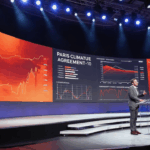As world leaders prepare for COP30 in Belém, Brazil, in November 2025, the backdrop couldn’t be more concerning. The fragmentation of global climate cooperation, driven by escalating geopolitical tensions and shifting political priorities in major economies, has fundamentally altered the trajectory we’re on. The climate modeling community has long warned us about different future scenarios—and the evidence increasingly suggests we’re tracking closest to the SSP3-7.0 pathway, a future characterized by regional rivalry, nationalism, and limited international cooperation on climate action.
This isn’t the catastrophic worst-case scenario, but it’s far from the ambitious 1.5°C pathway the Paris Agreement envisioned. SSP3-7.0 represents a world where global mean temperatures could rise by 2.8-4.6°C by 2100, with profound implications for ecosystems, economies, and societies. What makes this scenario particularly relevant today is not just its temperature projections, but its underlying assumptions: a world of fragmented governance, slower technological transfer, persistent inequalities, and regions prioritizing security and self-sufficiency over collective action.
For business leaders, COP30 represents more than another climate summit. It’s a critical inflection point to understand the world we’re actually operating in—not the one we hoped for—and to recognize that waiting for coordinated government action is no longer a viable strategy. The question isn’t whether businesses should lead on climate adaptation and just transition; it’s how quickly they can mobilize the resources, innovation, and value chain transformation needed to change course. This is where strategic sustainability consulting and innovative financial structuring become not just valuable, but essential to corporate survival and prosperity.
Understanding SSP3-7.0: The Fragmented World We’re Navigating
The Shared Socioeconomic Pathway 3 with 7.0 watts per square meter of radiative forcing—SSP3-7.0—paints a picture that should feel uncomfortably familiar to anyone watching current geopolitical developments. This scenario envisions a world of “regional rivalry” where countries increasingly look inward, international cooperation weakens, and the global community struggles to address collective challenges like climate change effectively.
Recent trends validate this trajectory more than we’d like to admit. The return of protectionist trade policies, the weaponization of energy supplies, the fracturing of technology ecosystems along geopolitical lines, and the rolling back of climate commitments in several major economies all point toward the fragmentation this scenario describes. When the United States—historically the world’s largest economy—oscillates on climate policy with each administration, when fossil fuel expansion continues despite net-zero pledges, and when climate finance commitments repeatedly fall short, we’re witnessing SSP3-7.0 dynamics in real time.
The implications are stark. Under this pathway, greenhouse gas emissions continue rising until mid-century before slowly declining, but by then, the cumulative carbon budget for limiting warming to 1.5°C or even 2°C will be long exhausted. We’re looking at a world where climate impacts intensify dramatically: more frequent and severe extreme weather events, significant sea-level rise affecting coastal populations and infrastructure, widespread ecosystem disruption affecting agriculture and water resources, and climate-induced migration at unprecedented scales.
What’s particularly concerning about SSP3-7.0 isn’t just the physical climate changes—it’s the reduced adaptive capacity it assumes. In a fragmented world, technology transfer slows, climate finance flows inadequately, and vulnerable regions receive insufficient support precisely when they need it most. The inequality between those who can adapt and those who cannot widens dangerously, creating not just humanitarian crises but also economic disruptions, supply chain vulnerabilities, and geopolitical instabilities that ripple globally regardless of borders.
This scenario also assumes slower progress on sustainable development, meaning continued pressure on natural resources, persistent poverty in many regions, and uneven access to clean energy and technology. For businesses, this translates to operating in an increasingly volatile, resource-constrained, and socially unstable environment—conditions that make long-term planning extraordinarily challenging without sophisticated risk assessment and adaptation strategies.
Business Implications: From Climate Risk to Strategic Imperative
For corporate leaders, the SSP3-7.0 context fundamentally reframes climate change from an environmental concern to a core business strategy challenge. The implications cascade through every aspect of operations, supply chains, markets, and stakeholder relationships.
Physical risks become operational realities. Companies are already experiencing production disruptions from extreme weather, damaged infrastructure from floods and storms, and reduced agricultural yields from droughts and heat. Under SSP3-7.0, these won’t be occasional disruptions but recurring operational challenges. Manufacturing facilities in flood-prone areas, agricultural supply chains dependent on climate-sensitive regions, and logistics networks vulnerable to extreme weather all face systematic threats that require fundamental redesign, not incremental adjustments.
Supply chain vulnerabilities multiply exponentially. The fragmented cooperation characteristic of SSP3-7.0 means supply chains can no longer rely on stable international relationships and smooth cross-border flows. Climate impacts in one region cascade through global value chains, but the international coordination needed to manage these risks effectively is weakened. Companies dependent on commodities from climate-vulnerable regions—whether coffee from Central America, cotton from South Asia, or minerals from Africa—face both physical supply risks and the social instability that climate stress generates.
Market disruptions accelerate across sectors. Consumer preferences are shifting toward sustainable products, but in an SSP3-7.0 world, this trend collides with reduced purchasing power in climate-impacted regions and protectionist policies that limit market access. Companies must navigate fragmented regulatory landscapes where climate standards vary dramatically by region, making global business models more complex and costly. Insurance costs escalate for climate-exposed assets, potentially rendering some business models economically unviable.
Workforce and human capital challenges intensify. Climate-induced migration creates both labor supply disruptions and new ethical responsibilities for businesses operating in affected regions. Worker health and safety concerns multiply as heat stress, air quality, and disease patterns worsen. Companies face growing pressure from employees, particularly younger workers, to demonstrate genuine climate leadership, not just public relations.
Financial and regulatory pressures converge. Even in a fragmented world, major financial centers are advancing climate-related disclosure requirements and sustainable finance frameworks. Companies unable to demonstrate credible transition plans and climate resilience face higher capital costs, limited access to green finance, and exclusion from major investment portfolios.
Perhaps most critically, the SSP3-7.0 context means companies cannot wait for governments to solve these challenges. The coordinated policy frameworks and international agreements that businesses have traditionally relied on to level playing fields and provide clear direction are weakening. This creates both risk—from policy uncertainty and fragmentation—and opportunity for companies willing to lead.
Changing Course: The Business Leadership Imperative and Ksapa’s Role
The sobering reality of tracking toward SSP3-7.0 doesn’t mean this trajectory is inevitable or unchangeable. Business leadership in climate adaptation and just transition can alter this course—but only with strategic sophistication, financial innovation, and operational scale that most companies cannot achieve alone.
The value chain transformation imperative requires companies to fundamentally rethink their supply chains not as cost-optimization exercises but as climate resilience and social equity systems. This means identifying climate vulnerabilities at every tier of the supply chain, investing in adaptive capacity for suppliers in vulnerable regions, and ensuring transition plans don’t abandon workers and communities in fossil fuel-dependent or climate-impacted areas. The complexity of this transformation—spanning multiple countries, sectors, and stakeholder groups—demands specialized expertise in both sustainability strategy and practical implementation.
Ksapa has pioneered approaches to value chain transformation that recognize this complexity. With 25 years of experience advising Fortune 500 companies and structuring a broad impact investment portfolio, we understand that genuine transformation requires integrating climate science, human rights due diligence, financial structuring, and operational change management. Our work spans the full spectrum from strategic assessment to on-the-ground program deployment, ensuring companies don’t just make commitments but achieve measurable impact.
Financial structuring for just transition at scale represents perhaps the greatest barrier to business climate leadership. The investments required—in renewable energy, climate-resilient infrastructure, worker retraining, and community support—run into billions of dollars globally. Traditional corporate budgeting and project finance approaches aren’t designed for this scale or complexity. Companies need innovative financial mechanisms that blend commercial returns with impact objectives, mobilize diverse capital sources, and distribute risks appropriately across stakeholders.
This is where Ksapa’s unique combination of consulting expertise and investment management creates distinctive value. We structure adaptation and transition programs that attract blended finance—combining corporate capital, impact investment, development finance, and philanthropic resources—to achieve scale impossible with any single source. Our experience managing significant impact portfolios means we understand investor requirements while maintaining focus on operational effectiveness and social equity.
Programmatic approaches enable speed and scale. Individual pilot projects and one-off initiatives, while valuable for learning, cannot deliver the speed of change needed to alter our climate trajectory. Companies need programmatic approaches that can deploy proven interventions across hundreds or thousands of locations simultaneously, adapt to local contexts while maintaining core principles, and measure impact rigorously to demonstrate value and enable continuous improvement.
Ksapa has developed and deployed such programs across G20, ASEAN and African markets, supporting smallholder farmers, strengthening labor rights, and building community resilience at scale. Our SUTTI initiative, for example, has reached thousands of small farmers with measurable improvements in income and environmental outcomes. This programmatic capability, combined with our multilingual capacity operating in five languages and understanding of diverse regulatory contexts, enables rapid deployment across the global footprint that major corporations require.
Strategic integration ensures business value, not just compliance. The most effective climate adaptation and just transition strategies don’t sit in CSR departments separate from core business operations—they reshape business models to create competitive advantage through resilience, unlock new markets through inclusive growth, and enhance brand value through authentic leadership. This requires C-suite engagement, integration with financial planning and risk management, and alignment with core business strategy.
Ksapa’s advisory work with Fortune 500 companies and large financial institutions, and our board-level advisory roles, reflect our capability to operate at the strategic level where these integration decisions occur. We don’t just recommend what companies should do—we help them understand why climate leadership creates business value, structure the governance to maintain momentum, and build the internal capabilities to sustain transformation beyond consulting engagements.
Taking Action: Partner with Ksapa to Lead the Transition
COP30 will generate headlines, commitments, and likely some disappointment given the fragmented cooperation context we’re operating in. But the summit’s true significance lies in what happens after—in the boardrooms and supply chains where actual transformation occurs or doesn’t.
The SSP3-7.0 trajectory we’re on isn’t predetermined, but changing course requires business leadership at a scale and sophistication not yet widespread. It requires moving beyond sustainability reports and net-zero pledges to fundamental transformation of how companies operate, invest, and create value. Most importantly, it requires recognizing that this transformation cannot happen without specialized support—the strategic clarity to navigate complexity, the financial innovation to mobilize resources at scale, and the implementation expertise to deliver results across diverse geographies and contexts.
Credit: Runway
Author of several books and resources on business, sustainability and responsibility. Working with top decision makers pursuing transformational changes for their organizations, leaders and industries. Working with executives improving resilience and competitiveness of their company and products given their climate and human right business agendas. Connect with Farid Baddache on Twitter at @Fbaddache.






